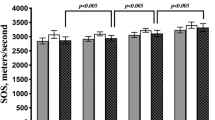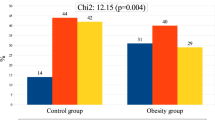Abstract
Background/Objectives:
Low habitual dietary calcium intake and vitamin D deficiency are common among Indian children. Using ‘laddoo’, an Indian snack, as a vehicle for administering calcium and vitamin D supplements, a randomized double-blind controlled trial was conducted for 12 months to assess its efficacy on total body less head (TBLH) bone mineral content (BMC) in underprivileged toddlers.
Subjects/Methods:
A total of 60 toddlers (mean age 2.7±0.52 years, boys=31) were randomized to two groups, (i) study group receiving one calcium fortified laddoo (cereal–legume snack) containing 405 mg calcium per day and (ii) control receiving a non-fortified laddoo, containing 156 mg of indigenous calcium. Both groups also received a laddoo fortified with 30 000 IU of vitamin D3 per month. Outcome measures included TBLH bone area (BA) and TBLH BMC by GE-Lunar DPX Pro Pencil Beam Dual-Energy X-ray absorptiometry.
Results:
At baseline, mean energy, protein and calcium intakes were 71, 72 and 47% of Indian Recommended Dietary allowances. In all, 87 and 83% toddlers were hypocalcaemia and vitamin D deficient, respectively. Mean TBLH BMC was 289.5±45.8 g. Post supplementation, mean TBLH BMC of study group showed a significantly greater (P<0.01) increase of 35% as against 28% in controls and the difference remained significant after adjusting for vitamin D status, calcium intake, height and TBLH BA.
Conclusions:
Daily supplementation with calcium fortified laddoo, and monthly vitamin D supplement resulted in a significant increase in TBLH BMC of underprivileged toddlers. We believe that such strategies have the potential of addressing nutritional problems in developing countries.
This is a preview of subscription content, access via your institution
Access options
Subscribe to this journal
Receive 12 print issues and online access
$259.00 per year
only $21.58 per issue
Buy this article
- Purchase on Springer Link
- Instant access to full article PDF
Prices may be subject to local taxes which are calculated during checkout

Similar content being viewed by others
References
Adu-Afarwuah S, Lartey A, Brown KH, Zlotkin S, Briend A, Dewey KG (2007). Randomized comparison of 3 types of micronutrient supplements for home fortification of complementary foods in Ghana: effects on growth and motor development. Am J Clin Nutr 86, 412–420.
Bhatia V (2008). Dietary calcium intake—a critical reappraisal. Indian J Med Res 127, 269–273.
Bonjour JP, Carrie AL, Ferrari IS, Clavien H, Slosman D, Theintz G et al. (1997). Calcium-enriched foods and bone mass growth in prepubertal girls: a randomized, double- blind, placebo-controlled trial. J Clin Invest 99, 1287–1294.
Cadogan J, Eastell R, Jones N, Barker ME (1997). Milk intake and bone mineral acquisition in adolescent girls: randomised, controlled intervention trial. BMJ 315, 1255–1260.
Chiplonkar SA, Agte VV (2007). Extent of error in estimating nutrient intakes from food tables versus laboratory estimates of cooked foods. Asia Pac J Clin Nutr 16, 227–239.
Ekbote VH, Khadilkar AV, Chiplonkar SA, Kant S, Khadilkar VV, Mughal MZ (2010a). Calcium bioavailability from a fortified cereal-legume snack (laddoo). Nutrition, e-pub ahead of print.
Ekbote VH, Khadilkar AV, Mughal MZ, Hanumante N, Sanwalka N, Khadilkar VV et al. (2010b). Sunlight exposure and development of rickets in Indian toddlers. Indian J Pediatr 77, 61–65.
Garza C, De Onis M (2004). WHO Multicentre growth reference study group rationale for developing a new international growth reference. Food Nutr Bull 25, 5–14.
Gopalan C, Ramasastri BB, Balasubramanyam SC (1998). Nutritive Value of Indian Food. Indian Council of Medical Research, National Institute of Nutrition: Hyderabad, India.
Indian Council of Medical Research (ICMR) (2003). Nutrient Requirements and Recommended Dietary Allowances for Indians. A Report of the Expert Group of the Indian Council of Medical Research. National Institute of Nutrition: Hyderabad, India, p 41.
Johnston Jr CC, Miller JZ, Slemenda CW, Reister TK, Hui S, Christian JC et al. (1992). Calcium supplementation and increases in bone mineral density in children. N Engl J Med 327, 82–87.
Lambert HL, Eastell R, Karnik K, Russell JM, Barker ME (2008). Calcium supplementation and bone mineral accretion in adolescent girls: an 18-mo randomized controlled trial with 2-y follow-up. Am J Clin Nutr 87, 455–462.
Lee WTK, Leung SSF, Fairweathertait SJ, Leungl DMY, Tsang HSY, Eagles J et al. (1994a). True fractional calcium absorption in Chinese children measured with stable isotopes (42Ca and 44Ca). Br J Nutr 72, 883–897.
Lee WTK, Leung SSF, Ng MY, Wang SF, Xu YC, Zeng WP et al. (1993). Bone mineral content of two populations of Chinese children with different calcium intakes. Bone Miner 23, 195–206.
Lee WTK, Leung SSF, Wang SH, Xu YC, Zeng WP, Lau J et al. (1994b). Double-blind, controlled calcium supplementation and bone mineral accretion in children accustomed to a low-calcium diet. Am J Clin Nutr 60, 744–750.
Misra M, Pacaud D, Petryk A, Collett-Solberg PF, Kappy M, On behalf of the Drug and Therapeutics Committee of the Lawson Wilkins Pediatric Endocrine Society: Vitamin D deficiency in children and its management: review of current knowledge and recommendations. Pediatrics 122, 398–417.
National Institute of Nutrition NNMB Report No: 24 (2006). Diet and Nutritional Status of Population and Prevalence of Hypertension Among Adults in Rural Areas. ICMR: Hyderabad, India.
Pesce MA (2008). Reference ranges for laboratory tests and procedures. In: Kiegman RM, Behram RE, Jenson HB, Stanton BF (eds). Nelson TextBook of Pediatrics. Elsevier: New Delhi, pp 2944–2949.
Pettifor JM (1991). Dietary calcium deficiency. In: Glorieux FH (ed). Rickets. Nestle Nutrition Workshop Series, vol. 21 Raven press: New York. pp 123–143.
Puri S, Marwaha RK, Agarwal N, Tandon N, Agarwal R, Grewal K et al. (2008). Vitamin D status of apparently healthy schoolgirls from two different socioeconomic strata in Delhi: relation to nutrition and lifestyle. Br J Nutr 99, 876–882.
Ramakrishnan U, Neufeld LM, Flores R, Rivera J, Martorell R (2009). Multiple micronutrient supplementation during early childhood increases child size at 2 y of age only among high compliers. Am J Clin Nutr 89, 1125–1131.
Romanchik-Cerpovicz JE, McKemie RJ (2007). Fortification of all-purpose wheat-flour tortillas with calcium lactate, calcium carbonate, or calcium citrate is acceptable. J Am Diet Assoc 107, 506–509.
Rosado JL, Díaz M, Rosas A, Griffit I, García OP (2005). Calcium absorption from corn tortilla is relatively high and is dependent upon calcium content and liming in Mexican women. J Nutr 135, 2578–2581.
Ruiz JC, Mandel C, Carabedian M (1995). Influence of spontaneous calcium intake and physical exercise on the vertebral and femoral bone mineral density of children and adolescents. J Bone Miner Res 10, 675–682.
Specker B, Binkley T (2003). Randomized trial of physical activity and calcium supplementation on bone mineral content in 3 to 5 year old children. J Bone Miner Res 18, 885–892.
Specker B, Johannsen N, Binkley T, Finn K (2001). Total body bone mineral content and tibial cortical bone measures in preschool children. J Bone Miner Res 16, 2298–2305.
U.S. Department of Health and Human Services (2004). Bone Health and Osteoporosis: A Report of the Surgeon General. U.S. Department of Health and Human services, Office of the Surgeon General: Rockville, MD.
WHO/UNICEF/UNU (2001). Iron Deficiency Anaemia: Assessment, Prevention, and Control (WHO/NHD/01.3). World Health Organization: Geneva. p 33. (http://www.who.int/nut/documents/ida_assessment_prevention_control.pdf).
Acknowledgements
We thank the participating toddlers, their parents and staff at the Deep Gruha Center, Pune. We are grateful to Dr Prakash Oonavale, Dr Mrs Oonavale, Dr Trupti Kamat, Dr Shobha Udipi, Mrs Shamim Momin, Ms Pournima and Ms Deepa Pillay for their help with the trial. We are grateful to Dr Divate, Director HCJMRI for helping with the trial.
Author information
Authors and Affiliations
Corresponding author
Ethics declarations
Competing interests
The authors declare no conflict of interest.
Rights and permissions
About this article
Cite this article
Ekbote, V., Khadilkar, A., Chiplonkar, S. et al. A pilot randomized controlled trial of oral calcium and vitamin D supplementation using fortified laddoos in underprivileged Indian toddlers. Eur J Clin Nutr 65, 440–446 (2011). https://doi.org/10.1038/ejcn.2010.288
Received:
Revised:
Accepted:
Published:
Issue Date:
DOI: https://doi.org/10.1038/ejcn.2010.288
Keywords
This article is cited by
-
Vitamin D in pediatric age: consensus of the Italian Pediatric Society and the Italian Society of Preventive and Social Pediatrics, jointly with the Italian Federation of Pediatricians
Italian Journal of Pediatrics (2018)
-
Vitamin D Supplementation in Childhood – A Review of Guidelines
The Indian Journal of Pediatrics (2018)
-
Rickets
Nature Reviews Disease Primers (2017)
-
Vitamin D in epilepsy: vitamin D levels in epilepsy patients, patients on antiepileptic drug polytherapy and drug-resistant epilepsy sufferers
European Journal of Clinical Nutrition (2016)
-
Editorials
Indian Pediatrics (2014)



